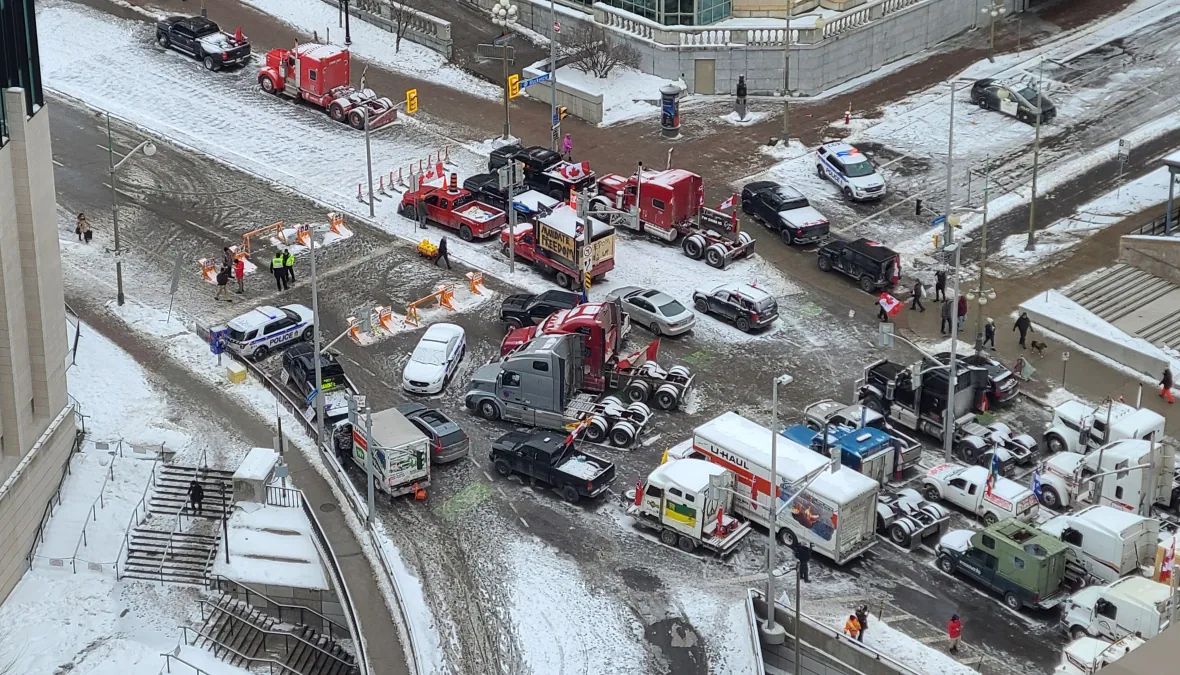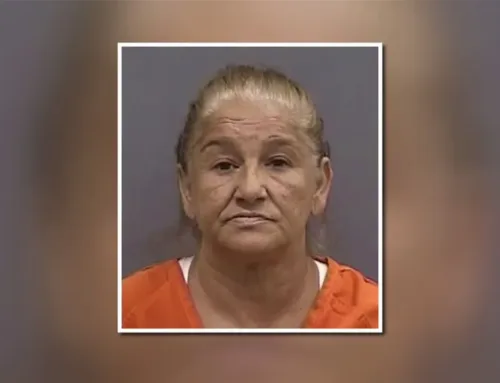February 7, 2022
-CBC
Heavy-duty towing experts say it will be difficult or impossible to remove the hundreds of heavy trucks entrenched in Ottawa’s downtown — unless the drivers allow it.
CBC counted 40 trucks on Kent Street and 109 on Wellington Street Friday, with dozens more on other streets spread around the downtown core. Then on Saturday, Ottawa police said 500 heavy trucks were in the so-called “red zone.”
Trucker Lloyd Crowe from Picton, Ont., has been parked just a couple of blocks away from Parliament Hill since last weekend, but he’s not worried about being towed.
“If you know anything about truck air brakes, once you pull that button, all 18 wheels are locked,” Crowe told CBC on Wednesday.
“Nothing can move it, except maybe a big wrecker. And no wrecker worth his salt is going to come anywhere near this, because they’re on our side.”
City struggling to find willing towing companies: sources
CBC spoke to multiple towing companies across Ontario and while many weren’t willing to be interviewed, several sources told CBC that the companies contracted by the City of Ottawa were refusing to tow trucks involved with the demonstration.
The city would not confirm or deny this, saying only that its bylaw department “uses several contracted services to assist with towing vehicles throughout the city.”
On Sunday, the city declared a state of emergency, which among other things will make procurement more flexible, according to city solicitor David White.
While the city likely has some vehicles with heavy-duty towing capacity for large OC Transpo vehicles, they also did not provide a response when asked how many they had.
Bylaw and regulatory services director Roger Chapman said in a statement that 28 vehicles associated with the protest had been towed “for impeding traffic and blocking laneways,” but it is not clear if any of those were commercial trucks.
Towing companies fear backlash
David Allen, president of Gary’s Towing in London, Ont., said while towing a truck that doesn’t want to be moved would be hard, it is physically possible — even if the air brakes are engaged.
Heavy-duty tow trucks can transfer air from their system to the trucks to release the brakes, Allen said. Failing that, they could “cage” the brakes, which involves manually backing the brake off each individual wheel.
“We have all the capabilities on our tow trucks to do it … but I don’t think anyone would want to,” he said.
That’s because many companies who provide heavy towing would be hesitant to risk their relationships with trucking companies, Allen said.
The backlash against tow trucks brought in to help clear the blockade at the border in Coutts, Alta., has dissuaded many towing companies from taking work in Ottawa, he noted.
“It’s the trucking industry you have to service on a regular basis,” Allen said. “It would be really detrimental to our business to get involved with something like that.”
‘Virtually impossible’ without driver co-operation
Heavy towing is a much more complicated process than towing a regular car or pickup, said Randy Whan, who owns Ward’s Towing in Kingston, Ont.
Hooking up a commercial truck to a heavy-duty tower — sometimes called a “wrecker” — takes at least 30 minutes, Whan said.
They have to hook onto the truck’s front axle, then supply air to the truck to release the brake and remove a driveline of some kind — difficult or almost impossible without the driver’s co-operation, Whan said.
“In the end … the trucker’s going to say whether you’re taking that truck away or not.”
He added the average large truck has a lot of equipment, such as chains weighing 15 kilograms or more, that could be used to prevent someone from towing their vehicle without consent.
Hooking up the truck also puts the employee in a vulnerable position, as they need to go under the truck, he added.
“I honestly can’t see it being done,” he said. “Every person that would send a [tow] truck in there is putting their driver at risk for being injured … You start removing those vehicles, you’re going to have some pretty angry people.”
Could take several days
With hundreds of trucks parked downtown, removing them all — if it could be done — would still take multiple days of round-the-clock effort.
Even in a best-case scenario with driver co-operation, it would take at least 10 hours to tow just the 40 trucks on Kent Street, Whan said.
But there’s also the fact trucks are not often stopped in the ideal positions to tow, meaning workers have to spend extra time winching them.
“If you’re in a tight parking lot, or you’re hooking up on a 45-degree angle, obviously things are going to change a little bit and it’s going to be a little bit harder,” Whan said.
One previous job that involved towing more than 30 trucks and 28 cars in difficult positions took his company over 18 hours, he said.
It also takes time to tow the trucks to wherever they’re being relocated to, and if the City of Ottawa did attempt it, they’d need to find a sizable space to put them.
Trucks could come back
Police don’t think towing the trucks is an effective solution, said Matt Skof, president of the Ottawa Police Association.
“You can tow all you want — they’re just going to return to the location, so it hasn’t resolved the issue,” Skof said. “And where are you putting all these vehicles?”
Towing large trucks is “incredibly logistically difficult,” Skof said, and any trucks removed would likely be quickly replaced by new ones arriving. Even if barriers were set up to prevent their re-entry, that would just push the problem to another part of the city, Skof said.
“Blocking off the streets after you’ve towed everybody, [they could] then occupy another location outside of it,” he said. “Then you’ve done nothing.”
Some activists have alleged the Ottawa Police Service’s treatment of the truck convoy has displayed a double standard, since in November 2020, officers moved in on a group blocking an intersection to protest the force’s treatment of Black and Indigenous people within days.
But Skof said removing the convoy is a more difficult task: “You’re talking about pedestrians for one thing, versus vehicles that weigh thousands of pounds.”
The decisions on how to ultimately break up the protest lie with Ottawa police Chief Peter Sloly, Skof said.
Sloly said Saturday the force still does not have a timeline for removing all trucks.




